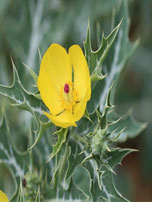SHAHEED KARTAR SINGH SARABHA AYURVEDIC MEDICAL COLLEGE & HOSPITAL
Affiliated to Guru Ravidas Ayurved University, Hoshiarpur Punjab
Affiliated to Guru Ravidas Ayurved University, Hoshiarpur Punjab

Botanical Name : Argemone mexicana Linn.
Family : Papaveraceae
Introduction :
Latin name : Argemone – Gk word Argema = cataract of the eye. This was a reputed cure; mexicana = of Mexico. English name Yellow thistle, Prickly or Mexican poppy.
Names in different Indian languages :
English : Prickly Poppy, Mexican Poppy
Hindi : Bhatbhamt, pharamgi dhattura
Kannada : Arasina, unmatta, datturigida
Malayalam : Ponnummattu, kanddankattari
Sanskrit : Swarnaksiri, brahmadanti
Tamil : Piramathandu, Kudiyotti
Telugu : Brahmadandicettu
Unani : Satyaanaashi
Synonyms :
Katuparni, Svarnkshiri, Kaanchan-kshiri, Pitadugdhaa. Hemaahvaa, Himaavati, Hemavati
Varieties & adulterants – (CV – controversy, AD – adulterants) :
Tricholepis glaberrima – CV
Morphology :
A thorny shrub 6-9 cms. high and oozes yellow latex if cut anywhere:
Leaves – long, thorny with irregular margins and white striations. Flowers – yellow with fivetender petals.
Fruit – round, 4-6 cms. in size.
Seed – like mustard seeds, black and numerous. They make noise like alcotol when put in the fire
This annual veedy herb, grows to a height of from i to 3 feet. Root long, subcylindrical ; stem erect, branching, prickly-bristled, and furnished, as the rest of the plant, with a gamboge-yellow milky juice. Leaves sessile, broadly lanceolate in general outline, sinuate lobed, spiny toothed, and blotched or striped with white along the principal veins. Iifloreseenee solitary in the axils of the upper leaves, and terminal; bads erect, pqdunculate flowers large, yellow, or rarely white., roundish, acuminate, often prickly, very fugacious. Petals 4 to 6, 2. e., twice as many as the sepals, roundish, more or less crumpled in the bud. Stamens indefinitely numerous; filaments filiform, greatly attenuated at the apex; anthers large, innate. Ovary strictly 1-celled; style almost none;, stellate-radiate, purple, velvety on the receptive surface; lobes reflexed. .P’-uit an oblong-ovate, prickly pod, opening by 3 to 6 valves at the apex, leaving a skeleton of from 3 to 6 filiform placentm in the shape of the original pod; seeds globular, crested, and pitted
Distribution & Habitat :
All over India, but mainly on islands.
Chemical constituents :
Isoquinoline, berberine , protopine, Sanguinarine
Properties :
RASA-tikta
GUNA-laghu, sara
VIRYA-ushna
VIPAKA-katu
Karma : virechan, kanduvinasaka,
epidemic dropsy, diarrhea, induces toxicity, purgation, sedative
Indication :
Kandu, krimi, sopham,, vataraktam
Latex. is useful in blood disorders, syphillis, oedema, dysuria. pyuria. caculi. dermatoses and typhoid.
Powdered seeds – useful in cold, cough and asthma.
Part used :
Latex, seed, oil
Dosage :
Powdered roots – 1 to 2 gms; powdered
seeds – 2 to 3 gms; latex – 10 to 12 drops; oil – 25 to 40 drops and juice -5 to 10 ml.
External uses :
Latex, juice and seed oil has wound cleaning and healing properties and cure dermatoses. Root ground into paste is applied on inflammation and scorpion sting. Local application of an oil or paste of seeds is useful in osteoarthritis.
Mixture of 1 drop of latex and ghee is used as an eye drops in nightbindness and ulcers in the eye -Gana Nighantu.
Internal uses :
Being a laxative, extract of the whole plant or seed oil is used in constipation. flatulence and abdominal pain. 3 to 4 gms of powdered roots is given in tapeworm infestation. (It dose not develope laxation always but causes nausea and sometimes vomiting.)
